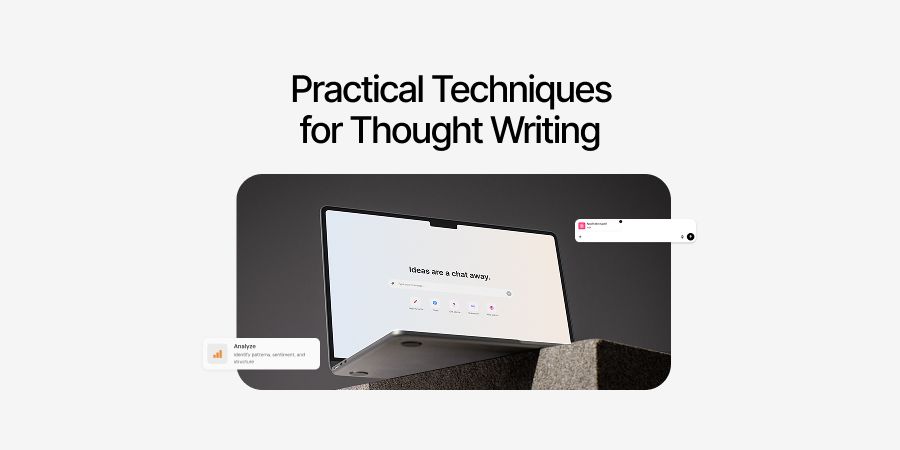
How to Write a Thought in a Narrative: Step-by-Step Guide
Writing thoughts inside a narrative can change how a story feels. It is not only dialogue or description that pulls readers in but also the unspoken words a character keeps to themselves.
Internal thoughts bring readers closer, show personal conflicts, and create depth that narration alone cannot provide. Many writers struggle with how to show thinking on the page without confusing readers or breaking flow.
That is where structure, technique, and consistency matter most.
Why Expressing Thoughts Matters in Storytelling
A character without visible thoughts often feels flat. Readers need access to inner reactions to understand motives and emotions. Adding thoughts gives a story credibility and intimacy. It is how a writer allows a reader to witness hesitation, doubt, or belief without long explanation.
-
Thoughts build a private connection between character and reader.
-
They reveal conflicts and dilemmas that actions alone cannot show.
-
They create realism by mirroring how people reflect internally.
-
They add emotional layers, making readers empathize more deeply.
A story may have fast action or a beautiful setting, but without inner voices it risks feeling empty. Thought writing is where readers discover why characters act the way they do, and where the story becomes personal.
Different Ways to Write Thoughts in a Narrative
There is no single way to put thoughts on the page. Writers choose based on point of view, style, and genre. Each method has advantages and limits.
Direct Thought (Italicized or Quoted)
Direct thoughts show exactly what the character is thinking. They often appear in italics or, less commonly, in quotation marks.
Example: I cannot believe she said that to me.
This style works well for sharp reactions or when a thought needs immediate clarity. It separates the voice from narration and signals a switch to the mind of the character.
Indirect Thought (Reported Style)
Indirect thought blends into narration. Instead of italics, the writer rephrases the thought as part of the text.
Example: She wondered if he was lying.
This technique is less disruptive to the flow. It is especially effective in third-person narratives where too many italics could overwhelm readers.
Stream of Consciousness
Stream of consciousness presents a continuous flow of thought. Sentences may appear fragmented or run together, reflecting raw mental activity. This approach is often used in literary fiction or modernist writing. It immerses readers in the texture of a character’s mind rather than polished statements.
Blending Thoughts with Narration
Some writers choose to integrate thoughts seamlessly with the story’s narrative voice. This is subtle and powerful when handled well.
Example: She closed the book and stared at the wall. Maybe tomorrow she would try again.
Here the line is not clearly set apart as dialogue or narration, but it still carries the character’s inner voice.
Formatting Rules for Writing Thoughts in a Narrative
Presentation is as important as content. A thought that looks misplaced or poorly formatted confuses readers and lowers narrative quality. Writers need to choose a consistent method and stick with it.
Use Italics Sparingly
Italics are the most common way to mark direct thoughts. They separate inner dialogue from narration clearly. The risk comes when every thought is italicized. Too much formatting creates visual clutter and weakens impact. Save italics for strong or immediate reflections.
Avoid Quotation Marks for Thoughts
Quotation marks belong to spoken dialogue. Mixing them with thoughts can blur distinction and mislead readers into thinking a line was spoken aloud. Instead, reserve quotation marks strictly for external speech and use italics or narration for mental dialogue.
Maintain Verb Tense Consistency
Shifts in tense can disorient readers. If the narrative is in past tense, keep the thought consistent unless the shift reflects how the character processes an idea.
Example: She walked into the room. This place feels wrong.
The thought remains in present tense, matching the immediacy of the mind, but the action stays in past tense. This balance ensures flow without confusion.
Place Thoughts Strategically
Dropping inner dialogue too often interrupts pacing. Position thoughts where they reveal stakes, tension, or decision-making. A well-placed thought can carry more weight than a long paragraph of narration.
Common Mistakes to Avoid in Writing Thoughts
Even skilled writers fall into traps when presenting character thoughts. Recognizing these errors helps maintain clarity and engagement.
-
Overloading with Thoughts
Too many thoughts crowd the page and slow the story. Readers lose patience if every action is paired with constant commentary.
-
Telling Instead of Showing
Saying She thought she was nervous does less than showing her hands trembling with the thought in context. Thoughts should enhance, not repeat, what the narration already shows.
-
Using Thoughts for Exposition Dumps
Some writers hide backstory inside thoughts. This breaks immersion and feels forced. Backstory belongs in narrative development, not long inner monologues.
-
Switching Styles Midway
A narrative that begins with italicized thoughts should not suddenly move to reported style without reason. Inconsistent presentation looks sloppy and distracts readers.
-
Blurring Narration and Thought Voice
Thoughts should reflect the character’s tone and personality. Narration may be neutral, but inner dialogue needs authenticity. Readers must feel the difference between authorial voice and character mind.
Showing Thoughts by Point of View
How a thought appears depends on narrative perspective. The method shifts between first person, third person limited, and omniscient. Each choice influences how much access the reader gets to the character’s mind.
First Person Narration
In the first person, thoughts flow naturally into the text. The entire story is told through the character’s lens, so inner dialogue blends with narration. Writers often remove formatting altogether because the distinction is implied.
Example:
I knew I had to keep walking. No one else would understand why, but stopping wasn’t an option.
The thought appears as direct narration, creating intimacy. The absence of italics or markers makes it seamless.
Third Person Limited
This point of view restricts the lens to one character but maintains some distance. Here, italics or reported style are more common. The writer chooses whether to present the thought directly or indirectly.
Direct Example:
She closed the door. He will never forgive me for this.
Indirect Example:
She closed the door, knowing he would never forgive her.
Both work, but direct thoughts feel urgent, while indirect thoughts blend with narration.
Omniscient Narration
Omniscient narrators reveal thoughts across characters, but this requires careful handling to avoid head-hopping. Clear transitions must signal whose mind the reader is entering.
Example:
James believed he was ready for the exam, but across the room, Sarah feared failure would ruin her future.
The narrator exposes both minds, offering balance, yet risks overwhelming the reader if too many shifts occur.
Balancing POV and Inner Dialogue
Regardless of perspective, the aim is clarity. Readers should never pause to ask if a line was spoken aloud or internally processed. Consistency in format reinforces voice, while thoughtful placement ensures rhythm in storytelling.
Examples of Thought Writing Across Genres
Writers in different genres approach thoughts differently. The mechanics stay consistent, but tone and placement shift depending on the type of story. Looking at examples across genres helps clarify when to use italics, indirect phrasing, or blended narration.
Literary Fiction
In literary works, thoughts often merge with narration. The boundary between external description and inner dialogue is thin, giving readers a sense of flow.
Example:
He stared at the rain sliding down the window. Maybe tomorrow would be different, though he doubted change ever came so quickly.
Here, the thought carries the same weight as description, pulling readers into a contemplative rhythm.
Mystery and Thriller
In suspense-driven writing, thoughts heighten tension and reveal strategy. Writers lean on direct inner dialogue to reflect fear or urgency.
Example:
The footsteps were closer now. If I run, he’ll hear me. If I stay, he’ll find me.
Short, fragmented thoughts keep the pace sharp, amplifying the sense of danger.
Romance
Romantic fiction often uses thoughts to expose vulnerability. These internal lines show emotions characters hesitate to voice.
Example:
She smiled at him across the table. Does he feel it too, or is this only in my head?
Fantasy and Science Fiction
Example:
The stars bent in strange arcs above the ship. If the map is wrong, we could drift for eternity.
Thoughts here are not just personal—they reinforce the scale and stakes of the imagined world.
Historical Fiction
Writers often use inner dialogue to reflect on cultural values or conflicts of the era. Thoughts provide context without heavy exposition.
Example:
He adjusted his uniform. Honor demanded obedience, but his heart rebelled at the order.
The thought clarifies tension, framing history through a personal lens.
Step-by-Step Guide to Writing Thoughts in Narrative
Step 1: Decide the Role of the Thought
Every inner reflection should serve a clear purpose. Does it reveal character motivation, create tension, or provide context? Identify this before adding it. Aimless thoughts clutter pacing and weaken the narrative.
Step 2: Choose Between Direct or Indirect Expression
Direct thoughts give immediacy. Example: I can’t trust him anymore. Indirect thoughts blend into narration. Example: She wondered if she could trust him again. Alternate between these styles to keep rhythm varied and the narrative flexible.
Step 3: Anchor the Thought in Action
Never let thoughts float in isolation. Connect them to the surrounding scene. A raised eyebrow, a clenched fist, or a pause in dialogue ties the thought to physical movement, creating a seamless blend.
Step 4: Use Natural Language Flow
Characters rarely think in structured essays. Capture authentic rhythm through fragments, interruptions, or emotional words. Thoughts should mirror how people process experiences in real time, not how they would write a polished reflection.
Step 5: Limit Over-Explanation
Readers can infer much from a single sharp thought. Avoid layering multiple lines of reflection that repeat the same point. Let the action and dialogue carry weight, with thoughts adding depth, not repetition.
Step 6: Edit for Pacing and Impact
After drafting, revisit every inner reflection. Ask: Does it push the story forward? Does it reveal something new? Cut or refine any thought that slows momentum or duplicates earlier insights.
Advanced Strategies for Writing Thoughts in Narratives
Layer Emotion into the Thought
A thought should never stand alone as a dry sentence. It works best when paired with sensory or emotional cues. Readers believe the thought more if it is anchored to a feeling.
Example:
Don’t panic. The paper shook in his hands, betraying the lie.
This shows the inner voice and the external evidence together, which makes it real.
Balance Internal and External Action
Thoughts must not drown out the scene. Pair them with gestures, pauses, or actions that mirror the inner dialogue. Hemingway often used sparse fragments of thought alongside action.
His characters rarely explained feelings – they revealed them in how they lit a cigarette or stared too long at a glass.
Shift Between Direct and Indirect Thought
Direct thoughts use italics or first-person phrasing. Indirect thoughts blur into narration. Skilled writers shift between them for rhythm. Toni Morrison did this in Beloved, where memory, thought, and narration flow into each other. This layering deepens character presence without overwhelming the page.
Keep Pacing in Mind
A narrative that leans too heavily on thought loses urgency. Stephen King has said that “the story is always moving forward,” and thoughts should serve that movement. Keep them short in tense scenes. Stretch them when the pace slows. This rhythm maintains reader engagement.
Use Thoughts to Create Contrast
One of the most effective strategies is to let a character’s words say one thing and their thoughts reveal another. This gap creates tension. Readers see the performance on the outside and the raw honesty within. The contrast builds layers of credibility and drama.
Why Strong Thought Writing Matters
-
Enhances reader engagement by mirroring real human patterns.
-
Strengthens character development without over-relying on dialogue.
-
Increases narrative clarity by showing intent, doubt, and conflict.
-
Boosts writing style authority with techniques drawn from acclaimed authors.
Conclusion – Mastering Thought Writing in Narratives
Key reminders to apply in your drafts:
-
Keep thoughts aligned with the character's inner voice.
-
Blend them with action and setting for realism.
-
Shift between simple and advanced techniques for variety.
-
Always check readability and clarity.
Thought writing is not filler. Done well, it becomes the heartbeat of a narrative. Writers who refine this skill will see their stories stand taller in both emotional depth and reader impact.
Frequently Asked Questions
Still got questions? Read through the most common questions or sign to ask Chatly whatever you have in mind.
More topics you may like

11 Best ChatGPT Alternatives (Free & Paid) to Try in 2025 – Compare Top AI Chat Tools

Muhammad Bin Habib

24/7 Customer Support with AI Chat: Benefits, Examples and More

Muhammad Bin Habib

28 Best AI Tools for Students in 2025 – The Complete AI-Powered Academic Success Guide

Muhammad Bin Habib

How to Prompt ChatGPT for a Sales Script

Muhammad Bin Habib

How to Write a Journalism Lead That Hooks Readers Instantly

Muhammad Bin Habib
